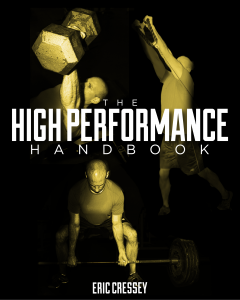
Strength Training Programs: 8 Strategies for Easily Maintaining Strength
In a post a while back, I made a comment that intrigued quite a few people:
I’ve always been amazed at how much volume it takes to attain a level of fitness, but how little volume it takes to maintain that level of fitness.
If you train yourself to run a six-minute mile, then take two months off from running, you can usually come back and get pretty darn close to that same time in spite of the detraining. However, chance are that you had to bust your butt to get to that six-minute time in the first place.
The same can be said of a 600-pound deadlift, appreciate level of mobility, or world-ranking in water chugging.
In short, once you’ve hit these milestones, they stick around pretty well, provided you don’t completely screw up and allow yourself to detrain. As a frame of reference, my best deadlift is 660, yet even though I don’t pull over 600 all that frequently (my competitive powerlifting days are likely over), I know I can do so just about any day of the week.
I’m always amazed at where my strength levels stand at the end of a long baseball off-season. I work some absurdly long hours from September through February when all our professional baseball players are around – and this definitely impacts how frequently I do much work in the 1-3 rep range with my lower body training. And, frankly, I don’t squat at all during this time of year because my knees are usually cranky from being on the hard floors all day. Interestingly enough, when I get some down-time when the pro guys go in-season, my squatting numbers haven’t fallen off much at all.
I don’t just think this is a valuable lesson for lifters who anticipate life interfering with optimal training dedication; I also think it’s a tremendously important message to older lifters who may not be able to load as frequently as they could in their younger years. To that end, here are some strategies for sustaining the strength one has built up over the years.
1. Avoid significant weight fluctuations (particularly down).
Nothing every sapped my strength more than losing five pounds. Maybe I was just hyper-sensitive to it because I competed at a lower weight class and always had to monitory my weight to the point of being neurotic, or maybe it was just because it slightly changed my range-of-motion and leverages on the squat and bench press. Regardless of what it was, a five pound drop in body weight equated to a 30-pound drop off my squat and 15-pound drop off my bench.
To that end, if you’re trying to keep your strength up during some down time in your strength training program, make sure to keep your weight up, too. It’s not the time to be skimping on calories (unless, of course, you have a lot of fat to lose as part of your fitness goals).
2. Eat right.
“Eating enough” and “eating right” are two completely different things. It would be very easy for me to just live on fast food during our busiest season. Instead, I still set aside time to prepare food for the long work day. I’m also fortunate to have a cafeteria 100 feet down the hallway, and they’ll cook me up whatever healthy food I need on the fly. I’ve got AG1, fish oil, and probiotics in my office, plus beef jerky and almonds in case I need solid food on the fly. “Busy” doesn’t have to mean “unhealthy” as long as you plan ahead.
3. Lift heavy at least once a month.
If you want to get strong, you need to put in at least 2-3 heavy lifting sessions per month for the lift in question. And, if you’re trying to trying to bring up a bench press, squat, deadlift, and chin-up simultaneously, you’ve got a lot of competing demands and overall training stress.
If, however, you want to stay strong, getting in just a few heavy sets of a particular movement each month can get the job done.
4. Get sufficient sleep.
No matter how busy life gets, I am pretty good about getting at least seven hours of sleep each night – and usually a little bit more. I’m typically in bed by 10PM and asleep by 10:30, then wake up between 6 and 7AM each day. I (like many others) have noticed that sleep before midnight makes me feel a lot better than trying to catch up by sleeping in the following morning.
5. Forget the deloads.
I’m a huge advocate of deloading periods in one’s training; in fact, I wrote an entire e-book about the topic!
However, if you’re going through a time when your normal training volume is compromised, you really aren’t “loading” enough to require a deload. You’re better off getting in your work whenever possible.
The obviously exception to this rule would be older lifters with appreciable levels of strength; they need to set aside specific deloading periods even if they are training with heavier sets less frequently.
6. Still crush your assistance work.
Just because you’re not feeling up to crushing a personal best squat doesn’t mean that you can’t still get after it with your single-leg work, sled pushing, glute-ham raises, or any of a number of other assistance exercises. Do your best to keep the resistance up on your assistance work instead of just getting your reps in. Sets in the 5-8 rep range are outstanding in this regard, as they’re heavy enough to have strength benefits, and the volume can help keep muscle on you, too.
7. Stick with multi-joint exercises.
If you maintain your strength on compound movements (e.g., chin-ups), you’ll maintain your strength on “sub-category” isolation movements (e.g., biceps curls) just fine. It doesn’t work the other way around, though.
If life is busy and you’re dragging when you get to the gym, you’re much better off hitting a set of deadlifts than you are doing some leg curls.
8. Consider rearranging your schedule or changing your strength training program split.
One of the biggest appeals of The High Performance Handbook I introduced was the versatility it provided via its 2x/week, 3x/week, and 4x/week strength training program options. Being able to shift from one approach to another as your schedule gets busier or lighter is valuable flexibility.
Additionally, it may be advantageous to plan your training for your less stressful days. If you work crazy hours Monday through Friday, try lifting Saturday and Sunday, then picking 1-2 days in the middle of the week for short sessions consisting of just assistance work.
These are eight strategies you can easily apply even when life isn’t easy and you want to maintain strength, but there are surely many more – some of which you’ll accidentally discover over the course of decades in the gym.





